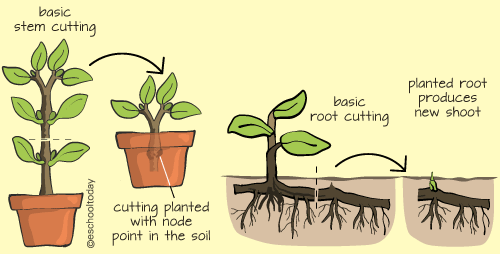Back to: AGRICULTURAL SCIENCE JSS3
Welcome to class!
In today’s class, we will be talking about the propagation of crops. Enjoy the class!
Propagation of Crops

CONTENT
- Meaning of Propagation
- Types of Propagation
Propagation simply means reproduction. Crops must propagate so that they can increase in numbers and also maintain their useful characteristics.
Methods of propagation
There are two types of propagation, these are sexual and Asexual/Vegetative propagation.
Sexual propagation:
Sexual Propagation involves planting crops using seeds. Seeds can be planted directly in the field or first in the nursery before being transplanted. Examples of seeds which are planted first in the nursery are oil palm, cocoa, coconut etc. common crops that that propagated sexually are cowpea (beans), maize, pawpaw, rice, groundnut etc.
A seed when planted undergoes the following processes.
- Germination: the process whereby the embryo of a seed resumes growth under favourable conditions.
- Emergence: this refers to the appearance of a seedling above soil level.
Conditions necessary for germination of seeds are
- Adequate moisture
- Viable seed (living embryo)
- Optimum temperature
- Adequate air
Advantages of sexual propagation
- Seeds are cheap to obtain.
- They are convenient to handle.
- The seeds are portable.
- They are easy to store.
- They are easy and cheap to transport.
- Seeds can be stored for longer periods.
- Crop population increase can easily be obtained through the use of seeds.
Disadvantages of sexual propagation
- Some seeds produce plants that do not resemble their parent plants
- Some seeds produce low yields during the first year
- Plants grown from seeds are usually not uniform in growth, maturity and yield
- Plants grown from seeds take a long time to mature and produce fruits
Evaluation
- What is propagation?
- Explain Sexual propagation
Asexual propagation:
Asexual propagation is the production of new plants from the parent plants using vegetative parts. The vegetative parts include the stem, leaves and roots. Asexual propagation is also called vegetative propagation. Plants that need to be propagated asexually possess the following characteristics:
- They do not produce seed e.g. pineapple
- They produce seeds but are not viable for planting e.g. Banana
- They take many years to mature and are easier to propagate via vegetative means e.g. cocoa.
Asexual propagation can be divided into five, namely:
- Division
- Cutting
- Layering
- Grafting
- Budding.
Division:
It is the propagation of plants from special vegetative organs that separate naturally from the parent plant.
Such organs include:
- Rhizomes e.g. ginger
- Suckers e.g. banana and plantain
- Bulbs e.g. onions
- Corm e.g. cocoyam
Evaluation
- What is asexual propagation
- List the four types of asexual propagation
Cuttings:
Plants parts are cut into portions to produce new plants from them. Cuttings can be obtained from stems, leaves and roots of plants and are used to propagate plants.
For example:
- Stem cutting is used to propagate cassava, sweet potato and sugarcane
- Root cutting is used to propagate breadfruit
- Leaf cuttings are used to propagate Bryophyllum.

Layering:
It is a method of vegetative propagation in which the stems or branches of plants are made to develop roots and give rise to another plan while they are still attached to the parent plant.

Grafting:
It is a method of vegetative propagation in which cut surfaces of two different (but closely related) plants are joined together so that they unite and grow as a single plant. The lower part of this union is called the stock while the top is called the scion.

Budding:
It is similar to grafting. Budding involves a desirable characteristic. The bud removed should have a piece of bark attached to it. The removed bud is then inserted into a cut already made in another plant called the stock. The inserted bud is the scion.

Evaluation
- Explain stem cutting.
- Explain layering and grafting.
Advantages of asexual propagation
- Plants are true to type, uniform in quality, growth habit and yield
- There is uniformity at maturity
- Is the only way to propagate plants that do not produce seeds
- Plants mature and start beaning fruit early
Disadvantages of asexual propagation
- Plants are usually very rigorous and therefore do not live long enough
- It is not possible to produce new varieties of plants
- Budding and grafting require special skills
- Virus diseases can be transmitted to new plants.
General evaluation
- What is Propagation?
- What is sexual propagation?
- List four types of vegetative propagation
- What is asexual propagation?
- Explain budding, layering and grafting
Project
Grow a plant (beans, aloe vera, maize, waterleaf, corchorus (ewedu), amaranthus (efo), okra in a seed pot using either sexual or asexual means.
Reading assignment
Answer revision questions from Junior Secondary Agriculture 3 for Nigerian Schools, Chapter 5, and Pages 51
Theory
1a. What is propagation?
1b. List four types of vegetative propagation.
2a. What is asexual propagation?
2b. Explain; cutting, layering and grafting.
We hope you enjoyed the class.
Should you have any further question, feel free to ask in the comment section below and trust us to respond as soon as possible.

nice teaching
ok i love your lesson
Thank you so much, I always love this site, it’s break the topics down for everybody to understand, thank you once again God bless you.
nice to find, you are absolutely doing 👍
thanks for the lesson
hi guy am new